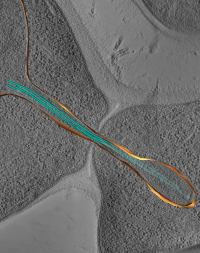 NEWS
NEWS
Breakthroughs in our understanding of the final stages of cell division
PRESS RELEASE
BREAKTHROUGHS IN OUR UNDERSTANDING OF THE FINAL STAGES OF CELL DIVISION
- Researchers at the Centre for Genomic Regulation (CRG) are shedding new light on the cell division process, a key process in embryonic development and the growth and proliferation of tumors.
- The study is to be published in the May edition of Nature Cell Biology magazine and identifies the agents that prevent cells from separating when DNA division is defective.
The cells in our bodies are constantly dividing. From embryonic development to adult life, cell division is necessary for tissue growth and renewal. During division, cells must duplicate their genetic material (or DNA) and ensure identical copies are passed along to the daughter cells. The entire process must work perfectly. If it doesn’t, the next generation of cells will not have the genetic material necessary to function properly. Proper regulation of cell division becomes especially relevant in situations in which cells proliferate rapidly, such as embryonic development or tumor proliferation.
Manuel Mendoza and his team at the Centre for Genomic Regulation, is studying the final stages of cell division where the genetic material is distributed and the cell divides into two. In their prior work, Dr. Mendoza’s team had outlined some of the mechanisms that orchestrate this process. In their new study, to be published in Nature Cell Biology, they describe the importance for cell survival of coordinating cell division with the separation of DNA.
During normal cell division, each DNA molecule is duplicated into two identical strands. These strands separate and migrate toward opposite poles of the cell. The cell’s mid-section then contracts and splits into two halves each with a copy of the DNA. Occasionally, due to problems that arise during DNA duplication, connections can be created between the strands of DNA that then impede their separation. As the migration toward the poles takes place, these connections hold the two separating masses of DNA together, leading to what we know as “DNA bridges” or “chromatin bridges”. These DNA bridges are a severe threat, as the cell could sever them during division and damage the genetic information passed on to the daughter cells. As a result of this, DNA bridges are a source of potential genetic instability and are frequently found in cancer cells.
The work of Dr. Mendoza’s group, which is carried out in yeast cells, shows that when there are problems with DNA replication, the resultant chromatin bridges send an alarm signal that temporarily halts the cell division process. This protects the DNA bridges by allowing them time to complete their separation without breaking, before final cell division. Dr Mendoza tells us “Our research is shedding new light on this process by revealing that the signaling pathway that we call NoCut is important to prevent damage to the DNA when there are problems in its replication. Interestingly, we have also identified that some types of DNA bridges, which are not originated by DNA replication problems, surprisingly generate no alarm signals”.
The work by Dr. Mendoza and his research group helps us to understand why and how cells detect certain DNA separation defects and not others. This could be important in our understanding of the damage to the genome that occurs in different human pathologies, such as cancer.
Reference work:
Nuno Amaral, Alexandre Vendrell, Charlotta Funaya, Fatima-Zahra Idrissi, Michael Maier, Arun Kumar, Gabriel Neurohr, Neus Colomina, Jordi Torres-Rosell, María-Isabel Geli & Manuel Mendoza. “The Aurora-B-dependent NoCut checkpoint prevents damage of anaphase bridges after DNA replication stress” Nature Cell Biology. May 2016. Nature Cell Biology. 18, 516–526 (2016). http://dx.doi.org/10.1038/ncb3343
Funding:
This work has been supported by the European Union through the European Research Council (ERC) - ERC Starting Grant no. 260965, the Ministry of Economy and Competitiveness, and the “la Caixa” Foundation.
For more information and interviews:
Centre for Genomic Regulation (CRG) – Press Officer - Laia Cendrós - Tel. +34 93 316 0237.
| Attachment | Size |
|---|---|
| 205.78 KB | |
| 204.8 KB | |
| 209.74 KB |



